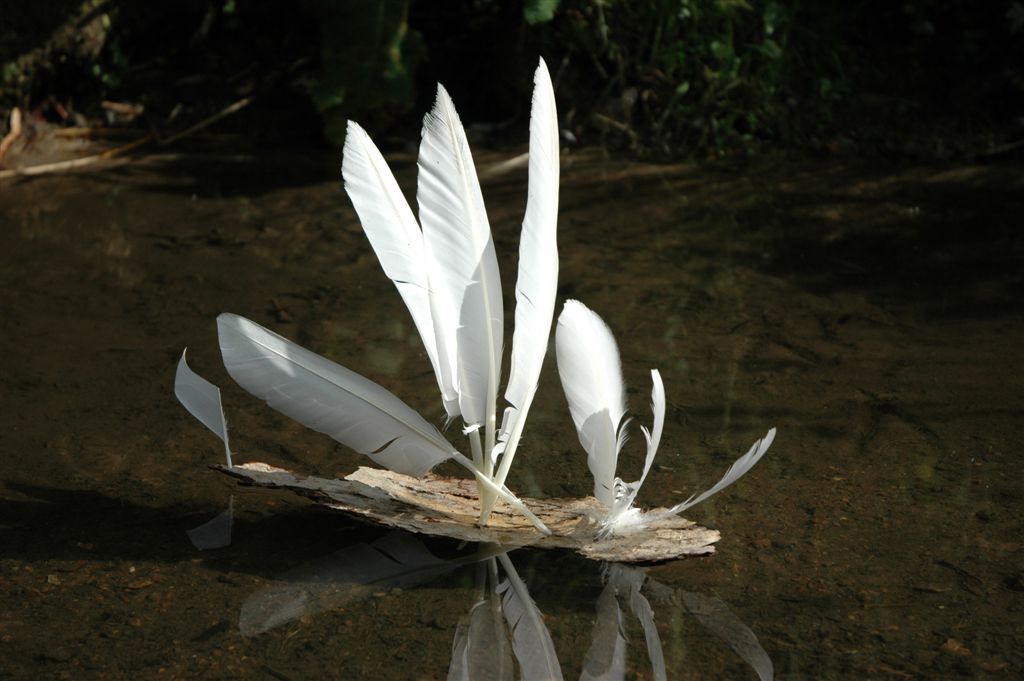 By the time it arrived at the edge of our campsite, the stream had grown up so that it was almost a river, and, being grown-up, it did not run and jump and sparkle along as it used to do when it was younger, but moved more slowly. It was still clear and shallow, but it knew where it was going, and that made it the perfect sort of river for playing Poohsticks.
By the time it arrived at the edge of our campsite, the stream had grown up so that it was almost a river, and, being grown-up, it did not run and jump and sparkle along as it used to do when it was younger, but moved more slowly. It was still clear and shallow, but it knew where it was going, and that made it the perfect sort of river for playing Poohsticks.
Poohsticks, as I expect you know, was invented by Winnie-the-Pooh when he was trying to make a rhyme about a fir-cone. He was walking in the Enchanted Forest, and when he came to the wooden bridge he tripped over something, and the fir-cone flew out of his paw and into the river. “Bother,” he said, but he wasn’t bothered for very long, because he realized that it was quite pleasant to watch the fir-cone float under the bridge and out the other side. Even more pleasant, he found, was to watch two fir-cones float under the bridge and guess which one would come out first. That was Poohsticks, and ever since Pooh and his friends have played it with cones and sticks and once, quite by accident, with Eeyore. But that’s another story.
Poohsticks is a funny sort of game, and when we played it in the grown-up river by our campsite I was thinking about just how funny it is. It isn’t a game you win, not exactly. It’s more that your stick wins, though that’s not right either, because your stick can’t do anything about where the river takes it, and it doesn’t care anyway. But it is still pleasant, somehow, to cheer sticks that don’t care to a victory that doesn’t matter.
Our friend Nell Greenfieldboyce wonders if we get attached to inanimate objects because we feel lonely. Josie Glausiusz, another friend, wonders if our feelings for things are an echo of early childhood, that enchanted time when trees talked back to us and stuffed animals weren’t pretend-real but real-real.
Or maybe Poohsticks is a never-ending Heider-Simmel experiment: we see two sticks, we make a story, once upon a time and happily ever after. We see a lazy summer day, we find a beginning, a middle, and an end.
We sat by the river near our campsite, watching the sticks float by, and after a while we added rudders made of smaller sticks and sails made from feathers and leaves. Now the sticks weren’t just sticks but boats, and we cheered for our own engineering and the tiny crafts we’d built. We cheered our pretend-real—or were they real-real?—Poohsticks down the river, and waved as they headed off, under their jaunty little sails, into the unknown water between us and the great ocean.
Maybe why doesn’t matter. Maybe what matters is that Poohsticks is really a very pleasant thing to play, especially on a campy afternoon when only the river knows where it is going. Maybe Christopher Robin can explain it all when he comes home.
Top photo by Flickr users Lenny&Meriel, who have played Poohsticks all over the world. Creative Commons.
Apologies to A.A. Milne for, well, everything.
Like this? Well yes, of course! Then you might like Paddle to the Sea: https://en.wikipedia.org/wiki/Paddle-to-the-Sea